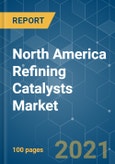The North America refining catalysts market is estimated to witness a significant growth, at an estimated CAGR of over 3.5%, over the forecast period. Increasing demand from refineries in the United States are expected to drive the market during the forecast period.
Key Market Trends
Fluid Catalytic Cracking (FCC) Catalysts to Dominate the Market
United States to Dominate the Market
Competitive Landscape
The North America refining catalysts market is consolidated in nature. Key players in the market include BASF SE, Albemarle Corporation, Haldor Topsoe A/S, Chevron Corporation, and W. R. Grace & Co.-Conn., among others.
Reasons to Purchase this report:
This product will be delivered within 2 business days.
- Volatility in precious metal prices are likely to hinder the market’s growth.
- By ingredient, the zeolites segment accounted for the largest market share and is expected to grow during the forecast period owing to the fact that it is used in almost all types of refining units with major consumption in fluidized catalytic cracking units.
- United States is expected to dominate the market and is also expected to witness the fastest CAGR during the forecast period.
Key Market Trends
Fluid Catalytic Cracking (FCC) Catalysts to Dominate the Market
- The fluid catalytic cracking (FCC) process plays a crucial role in refineries while producing lighter products from crude oil.
- FCC unit helps in converting a variety of feed types, such as cracked gas oil, gas oil, deasphalted gas oils, vacuum/atmospheric resins, and others, into lighter and high-value products, such as diesel oil, jet fuel, LPG, kerosene, and gasoline.
- In the FCC unit, the feedstock is heated at high temperature and moderate pressure. Along with this, the feedstock is brought in contact with a catalyst which helps to break the long-chain molecules of the high-boiling hydrocarbon liquids into small molecules, which are further collected in the form of vapors.
- In the FCC process, the catalysts are used in the form of fine powders. Previously, catalysts, such as amorphous silica-alumina were used for cracking vacuum gas oils in the FCC unit. However, in the early 1960s, zeolite was commercially introduced as FCC catalysts, which had been a significant advancement in the history of catalytic cracking.
- Owing to the aforementioned factors, FCC catalysts are of great importance in propelling the market demand for refining catalysts in the forecast period.
United States to Dominate the Market
- United States refining catalyst market is driven by the demand from petroleum refineries. United States petroleum refinery capacity continues to increase mainly because of increasing number of petroleum refineries.
- Secondary units, that support heavy crude oil processing and production of ultra-low sulfur diesel and gasoline, which include thermal cracking (coking), catalytic hydrocracking, and hydro-treating, have also registered a significant increase.
- Currently the U.S. government implementing international political gain policy claiming “energy dominance” by deregulating oil and gas production to further leverage rising United States exports.
- Due to the above-mentioned factors, the market for refining catalysts in the country is projected to grow during the forecast period.
Competitive Landscape
The North America refining catalysts market is consolidated in nature. Key players in the market include BASF SE, Albemarle Corporation, Haldor Topsoe A/S, Chevron Corporation, and W. R. Grace & Co.-Conn., among others.
Reasons to Purchase this report:
- The market estimate (ME) sheet in Excel format
- 3 months of analyst support
This product will be delivered within 2 business days.
Table of Contents
1 INTRODUCTION
4 MARKET DYNAMICS
5 MARKET SEGMENTATION
6 COMPETITIVE LANDSCAPE
7 MARKET OPPORTUNITIES AND FUTURE TRENDS
Companies Mentioned (Partial List)
A selection of companies mentioned in this report includes, but is not limited to:
- Albemarle Corporation
- Axens
- BASF SE
- Chevron Corporation
- Clariant
- DuPont
- Evonik Industries AG
- Exxon Mobil Corporation
- Haldor Topsoe A/S
- Honeywell International Inc
- JGC C & C
- Johnson Matthey
- W. R. Grace & Co.-Conn.
Methodology

LOADING...








